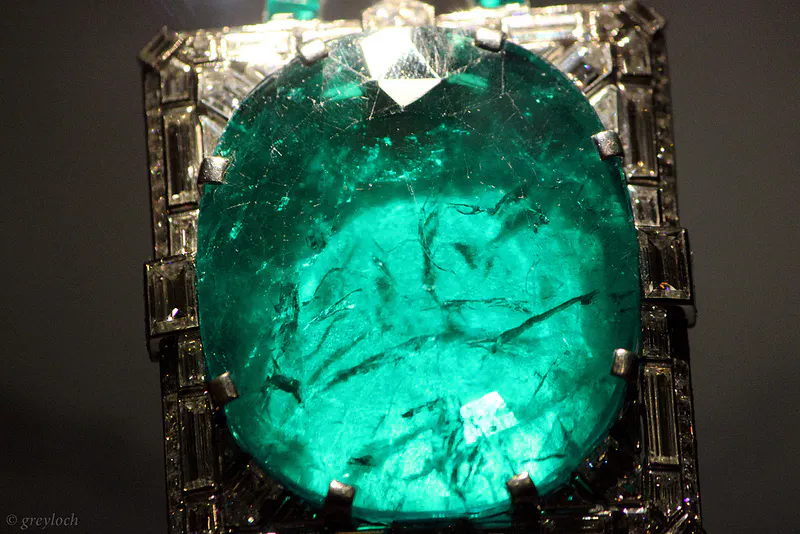What are Gemstone Absorption Spectra?
Learn how gems absorb wavelengths of light and how gemologists use gemstone absorption spectra to identify gems. There’s more to color than meets the eye!
3 Minute Read
What Does "Absorption" Mean?
Absorption spectra greatly influence gemstone coloration. When white light strikes a gemstone, the photons of particular wavelengths, or colors, are "absorbed" at the atomic level. Although colors are often described in terms of wavelengths of light, they can also be described in terms of frequencies, or vibrations, of light. Each specific wavelength has a corresponding frequency. When light frequencies match the frequencies of the atoms in a gemstone, the energy of the light vibration is added to the energy of the atomic vibration. The gemstone gets hotter as it "absorbs" light.
It may seem odd that gems can turn certain colors into heat, but there is a well-known example of objects turning colors into heat. Black-colored objects absorb all the wavelengths of visible light and convert them into heat. What we see as the color "black" is the absorption of all visible light. White-colored objects reflect all wavelengths of visible light, so they get neither heat nor any color from light beyond that of "white light." This is why black-colored clothes keep you warmer and white-colored clothes keep you cooler.
Gemstone light absorption isn't the same as the internal reflection of light within a faceted gem that contributes to gemstone dispersion. Light absorbed by a gemstone doesn't bounce about, trapped inside. Absorbed light exists only as heat.
What Happens to Non-Absorbed Light?
The gemstone colors we see don't come from the absorbed wavelengths of light. Keep in mind that absorbed light becomes heat. We need to consider the non-absorbed light.
A gem either transmits or reflects the non-absorbed wavelengths of light. Transparent gems transmit the non-absorbed wavelengths (allowing light to pass through), while opaque gems reflect them. Our brains process the non-absorbed wavelengths we see with the naked eye as colors.
Different gem species absorb, transmit, and reflect different wavelengths of light. These combinations are part of what give them their characteristic colors. For example, an emerald isn't green because it absorbs green wavelengths of light. Rather, we perceive the non-absorbed wavelengths from the emerald as the color green. Meanwhile, gemologists can observe a emerald's absorbed wavelengths through a spectroscope.
What Do Gemstone Absorption Spectra Look Like?
White light consists of all visible colors. Its spectrum, when dispersed through a prism, looks like a rainbow. A spectroscope disperses white light and also indicates the wavelengths of colors, usually measured in nanometers (nm) or billionths of a meter. Some spectroscopes measure wavelengths in ångströms (Å) or ten-billionths of a meter.
A spectroscope makes gemstone absorption spectra visible by directing white light into a gem and displaying the resulting rainbow of colors, minus those absorbed colors. These absorbed wavelengths of light appear as dark lines. Sometimes, entire areas of the spectrum or ranges of colors are absorbed and appear dark.
Gemologists can compare the absorption lines, areas, and patterns they see through a spectroscope with known gemstone absorption spectra to help identify a particular gem. Emeralds, for example, will display a distinct absorption spectrum: black absorption lines at 680 and 683 nm, an area of absorption between 580 and 630 nm, and an almost complete absorption of the violet end of the spectrum. Whether or not an emerald looks "emerald green," a real emerald will display this absorption spectrum.
Not all gemstones have distinctive absorption spectra that can identify them. Some gems require additional analysis for identification. Nevertheless, observing a gemstone's absorption spectrum can be a valuable gemological test.
Why Do Some Spectroscopes Display Absorption Spectra Differently?
There are two kinds of spectroscopes: diffraction grating and prism. Both work equally well and measure the same wavelengths.
Diffraction grating spectroscopes distribute the wavelengths evenly.
Prism spectroscopes distort the blue and red areas in order to make the absorption lines easier to see.
International Gem Society
Related Articles
Gemstone Facets: Terminology and Functions
An Introduction to Gemology
Gemstone Hardness and Wearability
Maw Sit Sit Guide
Latest Articles
800 Years of Mogok: A Celebration in Tenuous Times
What is the Average Gemstone Faceting Yield?
Pyroxmangite Value, Price, and Jewelry Information
How to Identify Emerald Simulants and Synthetics
Never Stop Learning
When you join the IGS community, you get trusted diamond & gemstone information when you need it.
Get Gemology Insights
Get started with the International Gem Society’s free guide to gemstone identification. Join our weekly newsletter & get a free copy of the Gem ID Checklist!
